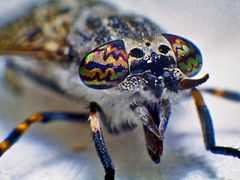Haematopota pluvialis
| Haematopota pluvialis | |
|---|---|
| | |
| Haematopota pluvialis | |
| Scientific classification | |
| Kingdom: | Animalia |
| Phylum: | Arthropoda |
| Subphylum: | Hexapoda |
| Class: | Insecta |
| Order: | Diptera |
| Family: | Tabanidae |
| Genus: | Haematopota |
| Species: | H. pluvialis |
| Binomial name | |
| Haematopota pluvialis (Linnaeus, 1758) | |
_-_2012-07-04.ogv.jpg)
Haematopota pluvialis, the Common Horse Fly or 'Notch-horned Cleg Fly', is a species belonging to the family Tabanidae subfamily Tabaninae.
This species is present in most of Europe, in the Near East and in eastern Palearctic ecozone.[1]
The adult females grow up to 12 millimetres (0.47 in) long and can be encountered during the daylight hours from late May through late August.

The large compound eyes necessary for locating their preys are brightly colored. The thorax is grey, with black longitudinal stripes. The abdomen has clearer bands at the end of each black segment. Also the wings have a distinctive pattern, being dark mottled by several clear spots. Legs are black, with yellowish-brown rings.
The females feed on mammal blood (hematophagy) (hence the Latin name Haematopota pluvialis, literally meaning 'blooddrinker of the rains'), needing blood for developing eggs. When they bite they inject fluids inhibiting the coagulation. In such a way blood flows out, allowing the horsefly to lap it. They are also able to bite people painfully.
References
- ↑ Ernest Edward Austen. Illustrations of British blood-sucking flies. British Museum of Natural History. p. 95.
- Stone, A.L. and Philip, B., 1974 - The Oriental Species of the Tribe Haematopotini (Diptera, Tabanidae), United States Department of Agriculture, Agriculture Research Service - Technical Bulletin, 1489 - Washington D.C.
- Ross, H.C.G. 1978 - A note on the hovering behaviour of Haematopota pluvialis (Linne, 1758) (Diptera:Tabanidae) Entomologist’s Gazttte 28:267-268
External links
| ||||||||||||||||||||||||||||||||||||||||||||||||||||||||||||||||||||||||||||||||||||||||||||||||||||||||||||||||||||||||||||||||||||||||||||||||||||||||||||||||||||||||||||||||||||||||||||||||||||||||||||||||||||